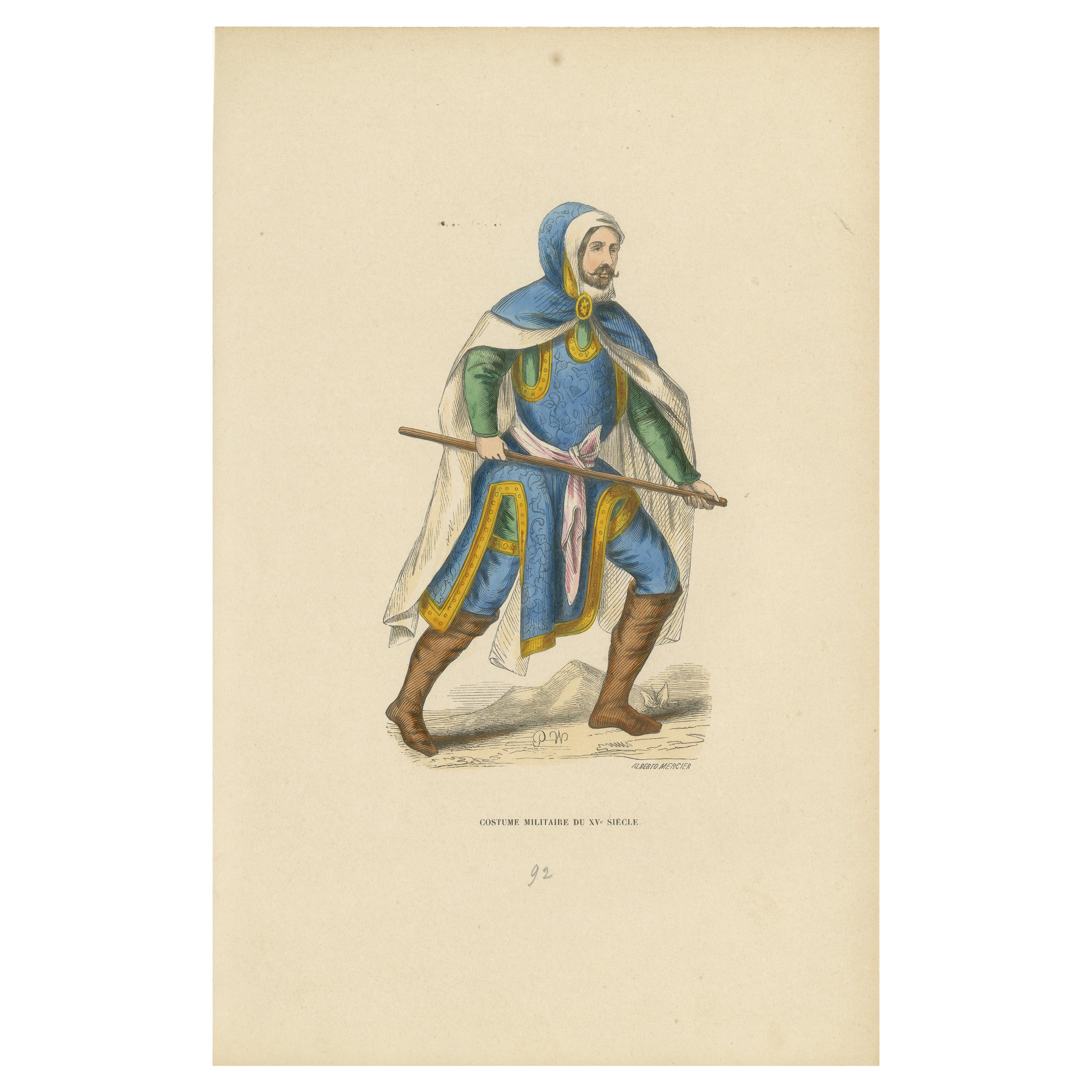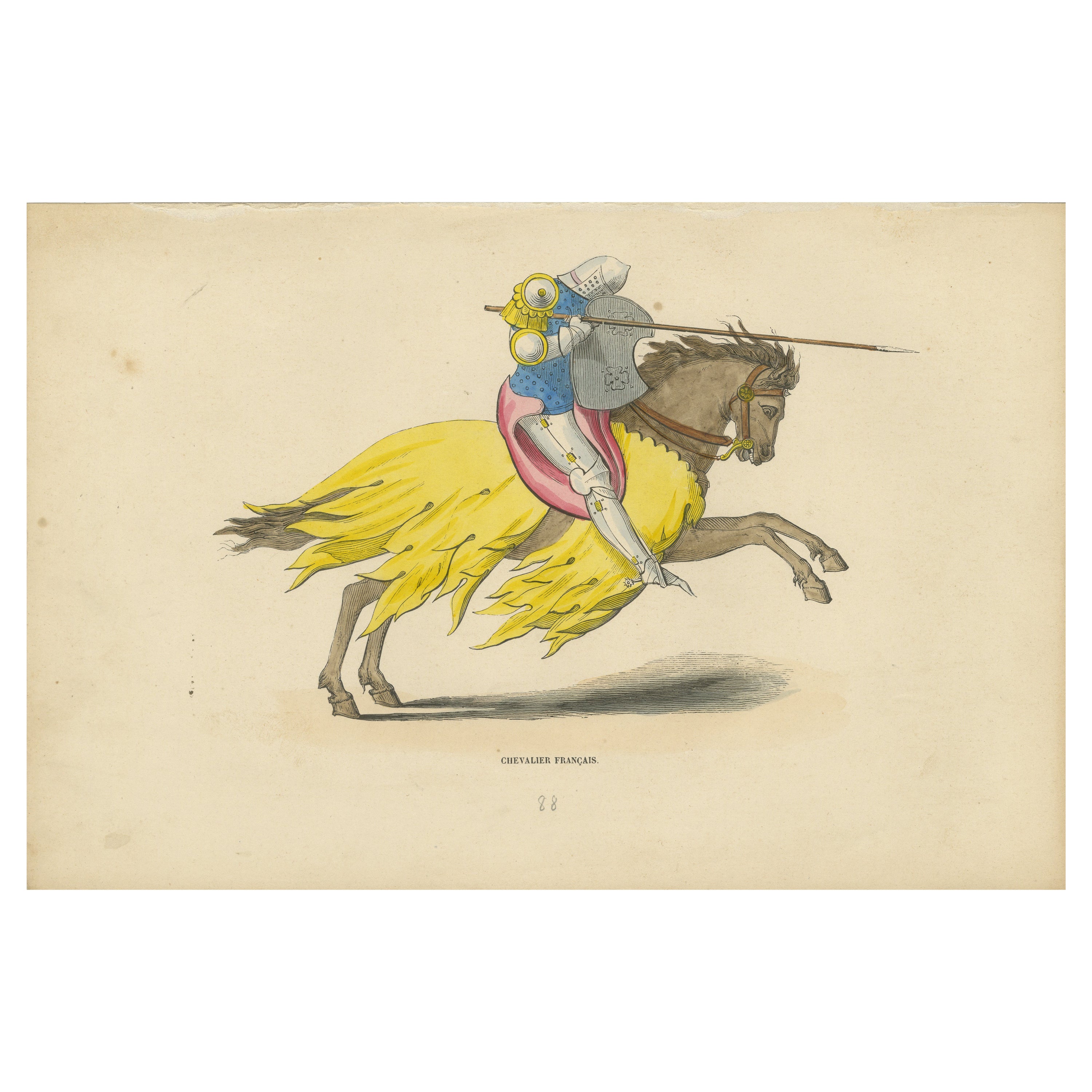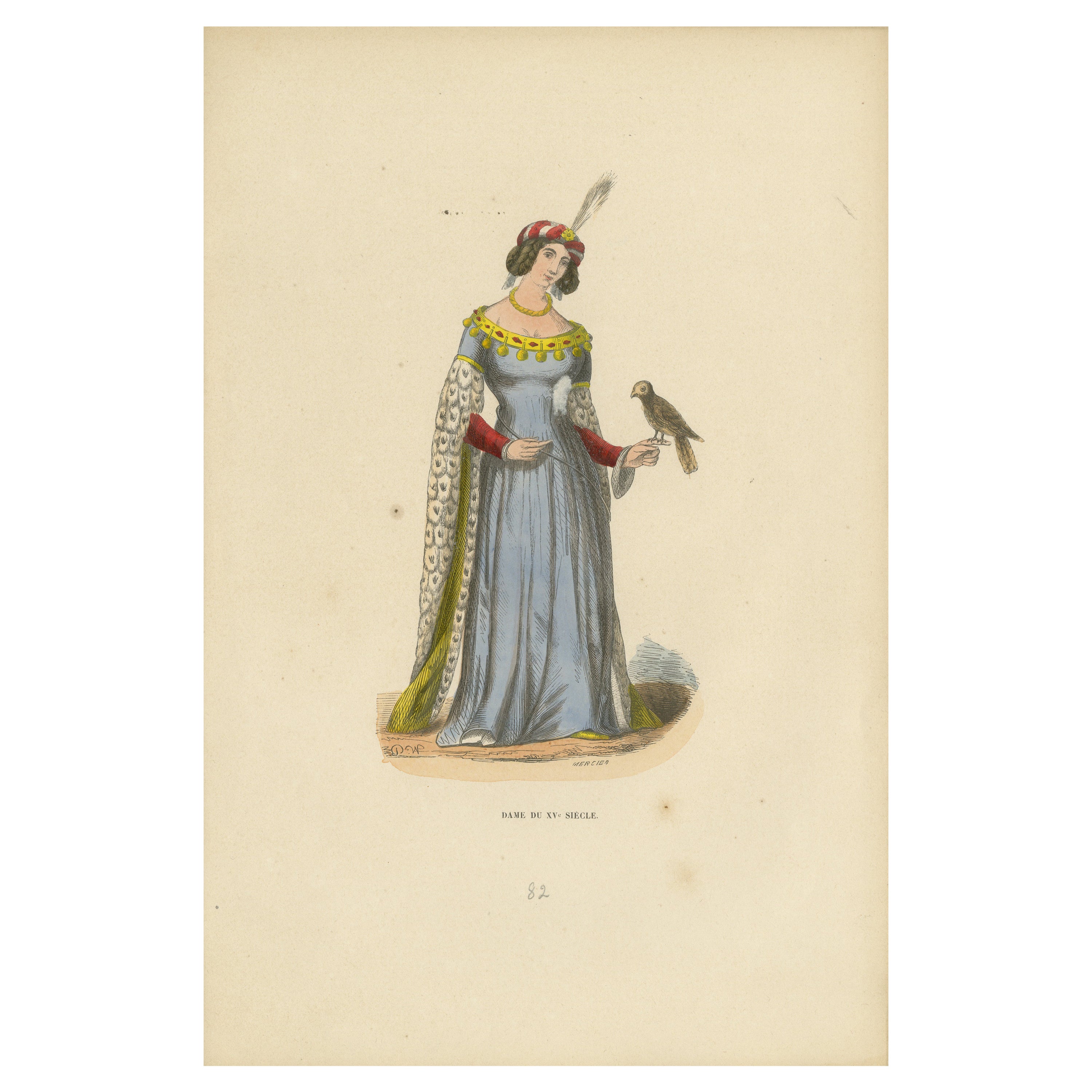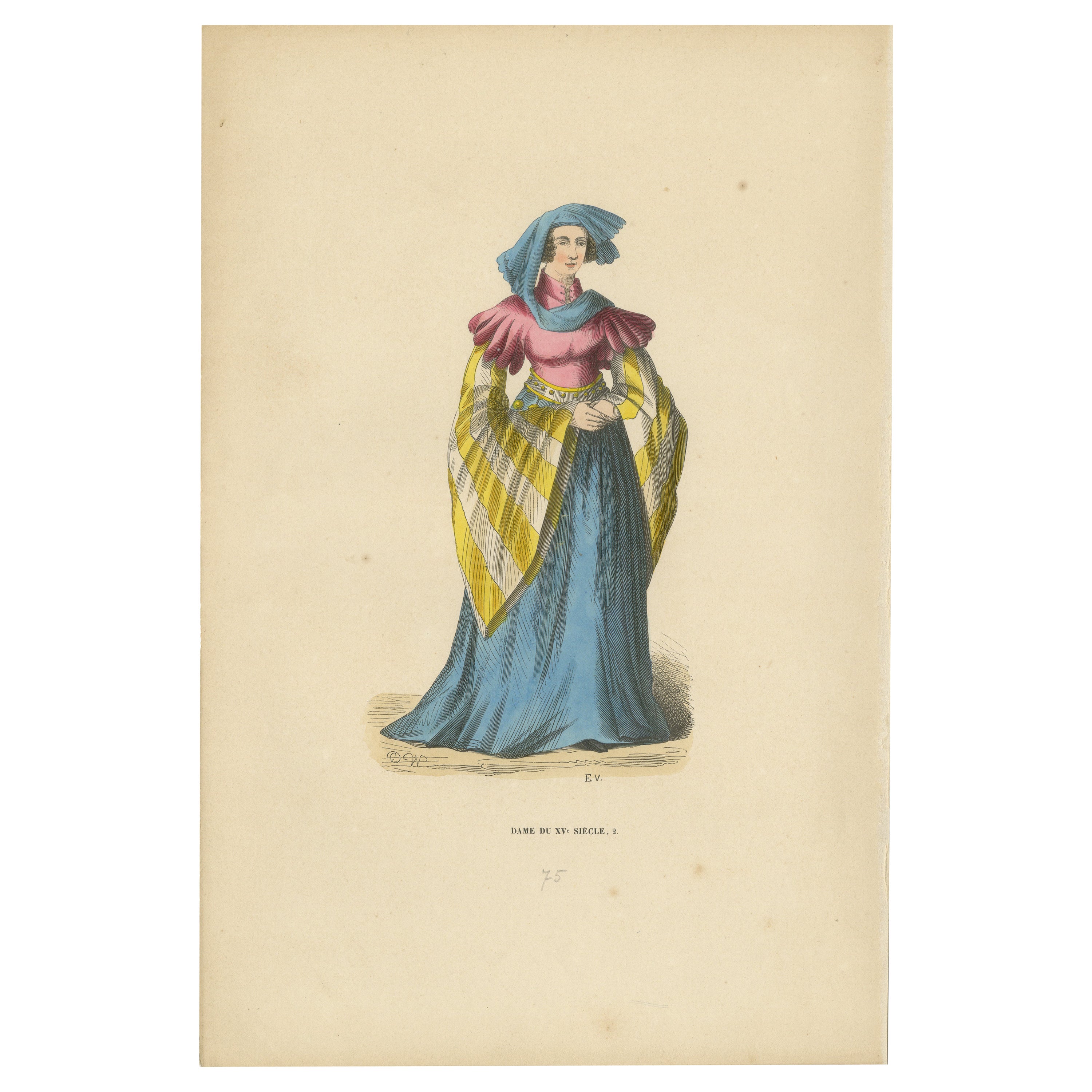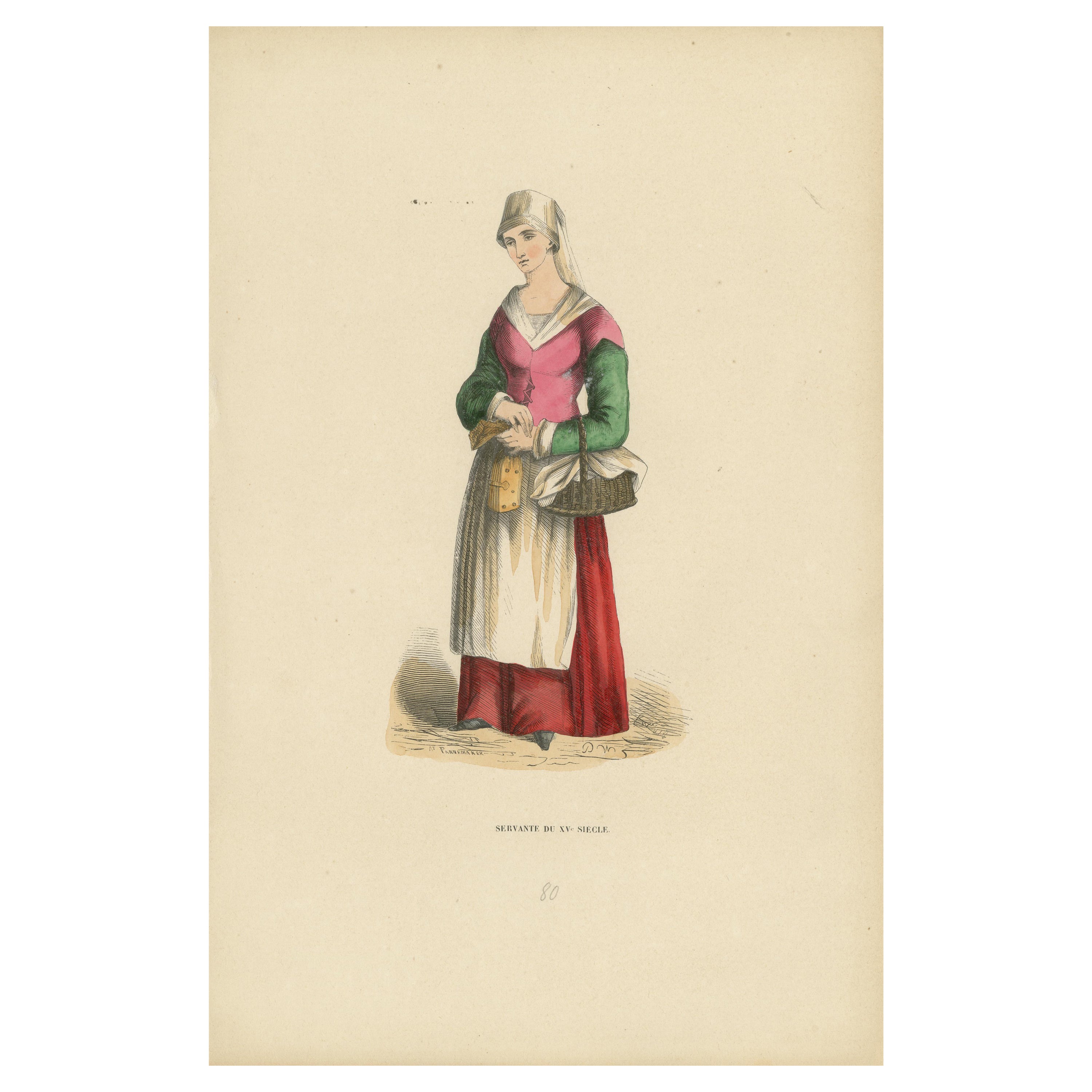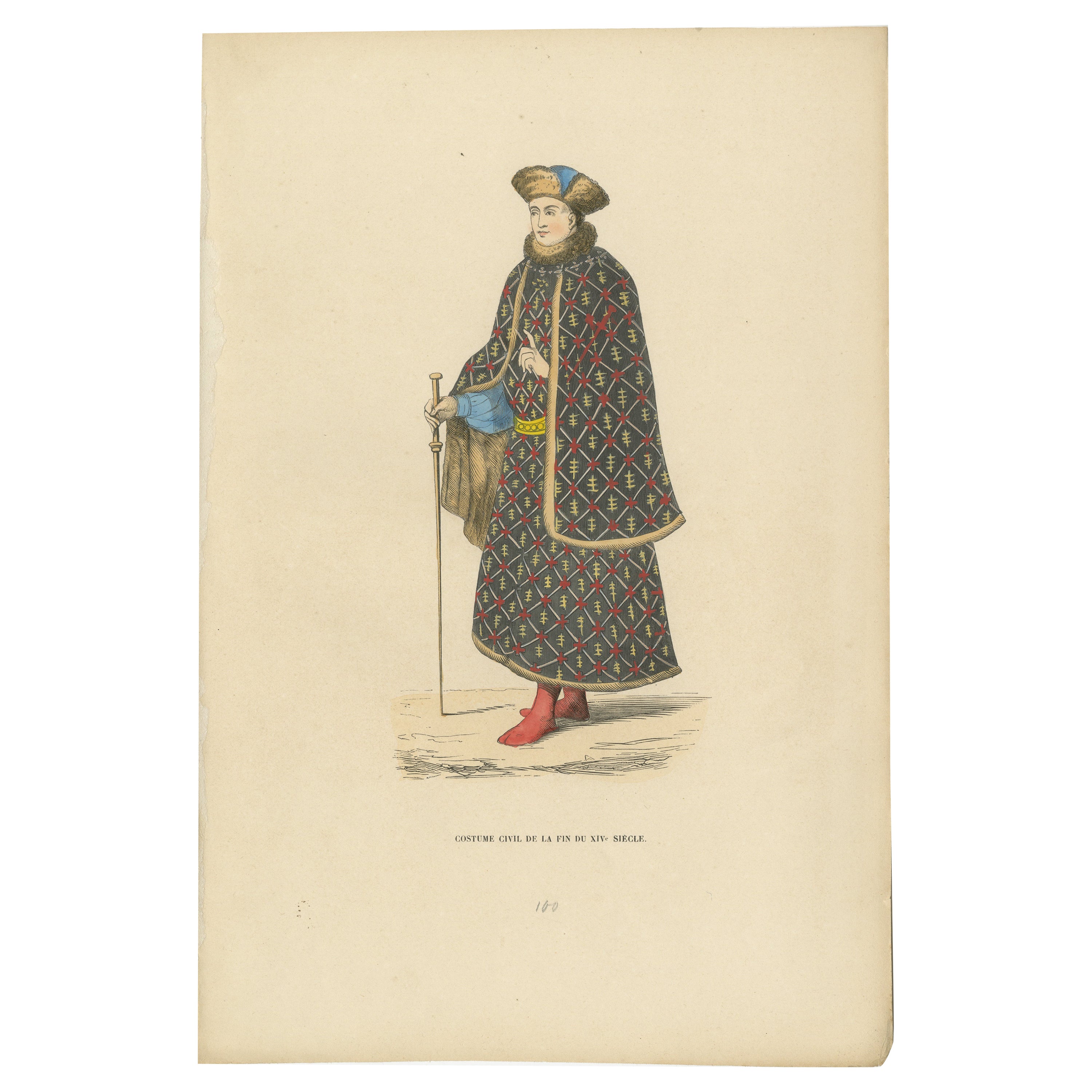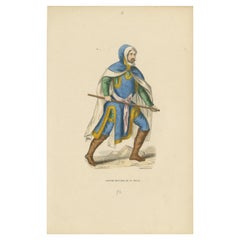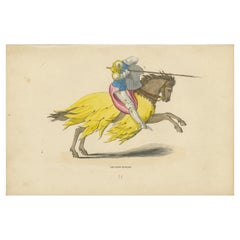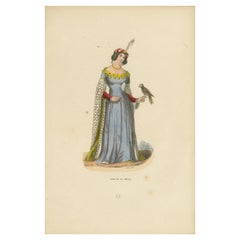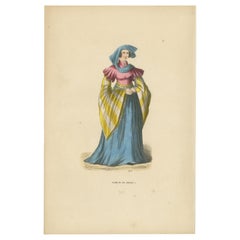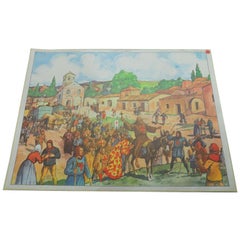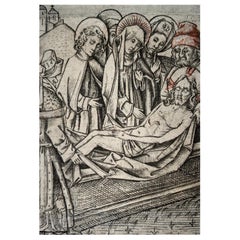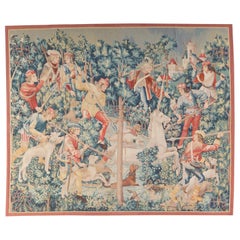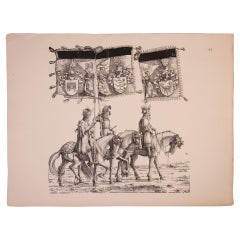Items Similar to Medieval Knight: Heraldry and Valor in 15th Century Garb, 1847
Want more images or videos?
Request additional images or videos from the seller
1 of 6
Medieval Knight: Heraldry and Valor in 15th Century Garb, 1847
About the Item
Title: "Chevalier" (Knight)
Description: This 1847 hand-colored engraving from the "Costume du Moyen Age" series depicts a "Chevalier," the French term for a knight. The image illustrates the noble bearing and elaborate attire characteristic of the medieval knighthood.
The knight is clad in a blue tunic with a decorative pattern, which likely signifies his status and heraldry. The tunic is edged with fur, a luxurious detail that also provides warmth. His attire is fitted closely to his body, indicating the tailored fit that was fashionable among the higher echelons of medieval society.
Around his waist, a yellow belt cinches the tunic, from which hangs a sheathed sword with a red scabbard, hinting at his readiness for battle or jousting. The hilt of the sword is detailed, suggesting it is a weapon of quality befitting a knight.
His head is adorned with a cap decorated with a pattern that matches the embellishments on his tunic, possibly indicating his loyalty to a liege or his personal coat of arms. His posture is confident, with one arm extended, perhaps in a gesture of greeting or command.
The knight's hose are also blue, and his shoes appear to be practical for walking or riding. The overall appearance of the knight, with his hand on the sword and his assertive stance, captures the essence of the chivalric ideals of courage, honor, and readiness to serve one's sovereign or cause.
This illustration provides a window into the romanticized vision of knighthood that was prevalent in the 19th-century historical revival and interpretation of medieval culture.
The colors have a nice glow over them. Historically, egg whites, known as glair, and sometimes egg yolk were indeed used in illumination and painting, particularly in manuscripts, to give colors a brighter appearance and to add a sheen or gloss to the work. This technique was quite common during the Middle Ages and into the Renaissance.
Egg whites can be applied as a varnish over pigments to enhance their brightness and to protect the colors. This application could make the colors appear more vivid and also add a slight glossy sheen to the surface of the image.
Egg yolk, on the other hand, was commonly used as a binding agent in paint. It forms the basis of tempera paint, a medium that was widely used before the advent of oil painting. Egg yolk helps to create a durable and long-lasting color that adheres well to various surfaces.
In the context of the print from 1847, it's less likely that egg whites or yolks were used directly on the print, as by that time, commercial printing processes would have been more advanced and less reliant on such manual methods. However, if this print is a representation of an earlier style or is meant to mimic the appearance of hand-painted manuscripts, the original artists might have employed techniques or materials that gave a similar effect to those achieved with egg-based binders and varnishes.
- Dimensions:Height: 10.63 in (27 cm)Width: 7.09 in (18 cm)Depth: 0 in (0.02 mm)
- Materials and Techniques:
- Period:
- Date of Manufacture:1847
- Condition:Good. Overal light toning and light soiling but the image itself clean and hand-colored almost 200 years ago and still in expliciet colors. Aged paper with typically warm, yellowish-brown hue, mostly around the edges. Study the images carefully.
- Seller Location:Langweer, NL
- Reference Number:Seller: BG-13635-961stDibs: LU3054337906912
About the Seller
5.0
Recognized Seller
These prestigious sellers are industry leaders and represent the highest echelon for item quality and design.
Platinum Seller
Premium sellers with a 4.7+ rating and 24-hour response times
Established in 2009
1stDibs seller since 2017
2,418 sales on 1stDibs
Typical response time: <1 hour
- ShippingRetrieving quote...Shipping from: Langweer, Netherlands
- Return Policy
Authenticity Guarantee
In the unlikely event there’s an issue with an item’s authenticity, contact us within 1 year for a full refund. DetailsMoney-Back Guarantee
If your item is not as described, is damaged in transit, or does not arrive, contact us within 7 days for a full refund. Details24-Hour Cancellation
You have a 24-hour grace period in which to reconsider your purchase, with no questions asked.Vetted Professional Sellers
Our world-class sellers must adhere to strict standards for service and quality, maintaining the integrity of our listings.Price-Match Guarantee
If you find that a seller listed the same item for a lower price elsewhere, we’ll match it.Trusted Global Delivery
Our best-in-class carrier network provides specialized shipping options worldwide, including custom delivery.More From This Seller
View AllVigilance in Blue: 15th Century Military Garb, 1847
Located in Langweer, NL
Title: "Vigilance in Blue: 15th Century Military Garb"
Description: This original handcolored historical illustration presents a military figure from the 15th century, clad in an or...
Category
Antique 1840s Prints
Materials
Paper
Charge of Valor: The Medieval French Knight, 1847
Located in Langweer, NL
Title: "Charge of Valor: The Medieval French Knight"
Description: This vibrant antique print captures the dynamic energy of a French knight in full gallop. ...
Category
Antique 1840s Prints
Materials
Paper
Noble Falconer: Lady of the 15th Century, 1847
Located in Langweer, NL
Title: "Noble Falconer: Lady of the 15th Century"
Description: This print captures the noble pastime of falconry, a sport historically associated with the aristocracy, through the p...
Category
Antique 1840s Prints
Materials
Paper
15th Century Elegance: Lady of the Court, Engraved and Published in 1847
Located in Langweer, NL
Title: "15th Century Elegance: Lady of the Court"
Description: This print presents a lady of the 15th century, elegantly attired in the fashion of the European high nobility. Her dr...
Category
Antique 1840s Prints
Materials
Paper
French Maid of the 15th Century: Daily Grace, Published in 1847
Located in Langweer, NL
Title: "Maid of the 15th Century: Daily Grace"
Description: This print portrays a servant or maid from the 15th century, captured in a moment of stillness, perhaps while going about...
Category
Antique 1840s Prints
Materials
Paper
Civilian Costume at the End of the 15th Century, 1847
Located in Langweer, NL
Title: "Civilian Costume at the End of the 15th Century"
Description: The image is a print from a series the "Costume du Moyen Age" dated 1847, and titled "Costume Civil de la Fin d...
Category
Antique 1840s Prints
Materials
Paper
You May Also Like
Retro 2-Sided Chart Medieval Castle Knights Crusade Historical Architecture
Located in Berghuelen, DE
The double sided vintage wall chart shows the departure of some knights for the crusades and a great hall inside a medieval castle. Colorful print on p...
Category
Mid-20th Century German Country Prints
Materials
Paper
$196 Sale Price
30% Off
1460 c Israhel van Meckenem, Burial of Christ, metalcut, mid-15th Century
Located in Norwich, GB
Attributed to the "Meister der Berliner Passion" from his Kleine Passion.
It is now considered almost certain that the Meister der Berliner Passion was in fact Israhel van Meckenem ...
Category
Antique 15th Century and Earlier Dutch Renaissance Prints
Materials
Paper
15th Century Gothic Tournai Design Medieval Unicorn Hunting Scene Recreation
Located in Secaucus, NJ
The unicorn capture” is recreated after “the hunt of the unicorn” series, found in the collection of François de la Rochefoucald and is currently housed in the cloisters division of ...
Category
Antique 15th Century and Earlier Chinese Tapestries
Materials
Wool
Engraving of Maximilian I° Roman Emperor "Knights in a Parade"
Located in Alessandria, Piemonte
ST/728-2. Engraving of Maximilian I°, Roman emperor, from the original engravings "The triumph of Maximilian " of the 16th and 17th centuries by Albrecht...
Category
Early 20th Century European Other Prints
Materials
Paper
15th Century Ferronerie Silk Velvet
By Aubusson Manufacture
Located in Canterbury, GB
Voided Olive Green silk velvet showing the Ferronerie pattern
Left and Right panels from a dismantled Chasuble
Joined and made up from several sections
Florence or Venice dating...
Category
Antique 15th Century and Earlier Italian Tapestries
Materials
Velvet
15th Century Ferronerie Silk Velvet
By Aubusson Manufacture
Located in Canterbury, GB
A panel of voided Olive Green silk velvet showing the Ferronerie pattern
Centre panel of a dismantled Chasuble
Florence or Venice dating from second half of the 15th Century
The s...
Category
Antique 15th Century and Earlier Italian Baroque Tapestries
Materials
Velvet
